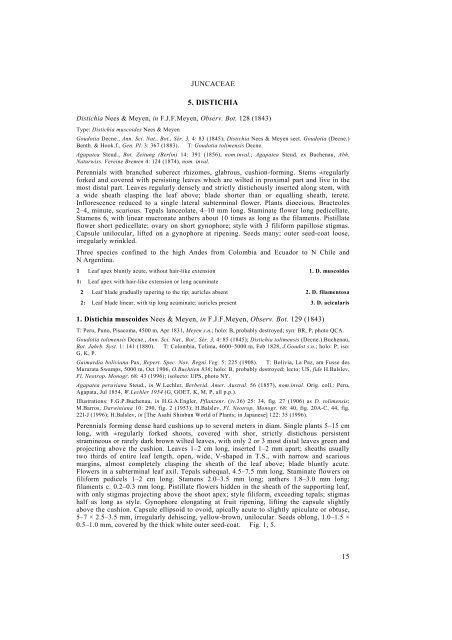Part 6. JUNCACEAE 1: Rostkovia to Luzula - Species Plantarum ...
Part 6. JUNCACEAE 1: Rostkovia to Luzula - Species Plantarum ...
Part 6. JUNCACEAE 1: Rostkovia to Luzula - Species Plantarum ...
You also want an ePaper? Increase the reach of your titles
YUMPU automatically turns print PDFs into web optimized ePapers that Google loves.
<strong>JUNCACEAE</strong><br />
5. DISTICHIA<br />
Distichia Nees & Meyen, in F.J.F.Meyen, Observ. Bot. 128 (1843)<br />
Type: Distichia muscoides Nees & Meyen<br />
Goudotia Decne., Ann. Sci. Nat., Bot., Sér. 3, 4: 83 (1845); Distichia Nees & Meyen sect. Goudotia (Decne.)<br />
Benth. & Hook.f., Gen. Pl. 3: 367 (1883). T: Goudotia <strong>to</strong>limensis Decne.<br />
Agapatea Steud., Bot. Zeitung (Berlin) 14: 391 (1856), nom.inval.; Agapatea Steud. ex Buchenau, Abh.<br />
Naturwiss. Vereine Bremen 4: 124 (1874), nom. inval.<br />
Perennials with branched suberect rhizomes, glabrous, cushion-forming. Stems ±regularly<br />
forked and covered with persisting leaves which are wilted in proximal part and live in the<br />
most distal part. Leaves regularly densely and strictly distichously inserted along stem, with<br />
a wide sheath clasping the leaf above; blade shorter than or equalling sheath, terete.<br />
Inflorescence reduced <strong>to</strong> a single lateral subterminal flower. Plants dioecious. Bracteoles<br />
2–4, minute, scarious. Tepals lanceolate, 4–10 mm long. Staminate flower long pedicellate.<br />
Stamens 6, with linear mucronate anthers about 10 times as long as the filaments. Pistillate<br />
flower short pedicellate; ovary on short gynophore; style with 3 filiform papillose stigmas.<br />
Capsule unilocular, lifted on a gynophore at ripening. Seeds many; outer seed-coat loose,<br />
irregularly wrinkled.<br />
Three species confined <strong>to</strong> the high Andes from Colombia and Ecuador <strong>to</strong> N Chile and<br />
N Argentina.<br />
1 Leaf apex bluntly acute, without hair-like extension 1. D. muscoides<br />
1: Leaf apex with hair-like extension or long acuminate<br />
2 Leaf blade gradually tapering <strong>to</strong> the tip; auricles absent 2. D. filamen<strong>to</strong>sa<br />
2: Leaf blade linear, with tip long acuminate; auricles present 3. D. acicularis<br />
1. Distichia muscoides Nees & Meyen, in F.J.F.Meyen, Observ. Bot. 129 (1843)<br />
T: Peru, Puno, Pisacoma, 4500 m, Apr 1831, Meyen s.n.; holo: B, probably destroyed; syn: BR, P, pho<strong>to</strong> QCA.<br />
Goudotia <strong>to</strong>limensis Decne., Ann. Sci. Nat., Bot., Sér. 3, 4: 85 (1845); Distichia <strong>to</strong>limensis (Decne.) Buchenau,<br />
Bot. Jahrb. Syst. 1: 141 (1880). T: Colombia, Tolima, 4600–5000 m, Feb 1828, J.Goudot s.n.; holo: P; iso:<br />
G, K, P.<br />
Gaimardia boliviana Pax, Repert. Spec. Nov. Regni Veg. 5: 225 (1908). T: Bolivia, La Paz, am Fusse des<br />
Murarata Swamps, 5000 m, Oct 1906, O.Buchtien 836; holo: B, probably destroyed; lec<strong>to</strong>: US, fide H.Balslev,<br />
Fl. Neotrop. Monogr. 68: 43 (1996); isolec<strong>to</strong>: UPS, pho<strong>to</strong> NY.<br />
Agapatea peruviana Steud., in W.Lechler, Berberid. Amer. Austral. 56 (1857), nom.inval. Orig. coll.: Peru,<br />
Agapata, Jul 1854, W.Lechler 1954 (G, GOET, K, M, P, all p.p.).<br />
Illustrations: F.G.P.Buchenau, in H.G.A.Engler, Pflanzenr. (iv.36) 25: 34, fig. 27 (1906) as D. <strong>to</strong>limensis;<br />
M.Barros, Darwiniana 10: 290, fig. 2 (1953); H.Balslev, Fl. Neotrop. Monogr. 68: 40, fig. 20A-C, 44, fig.<br />
22I-J (1996); H.Balslev, in [The Asahi Shinbun World of Plants; in Japanese] 122: 35 (1996).<br />
Perennials forming dense hard cushions up <strong>to</strong> several meters in diam. Single plants 5–15 cm<br />
long, with ±regularly forked shoots, covered with shor, strictly distichous persistent<br />
stramineous or rarely dark brown wilted leaves, with only 2 or 3 most distal leaves green and<br />
projecting above the cushion. Leaves 1–2 cm long, inserted 1–2 mm apart; sheaths usually<br />
two thirds of entire leaf length, open, wide, V-shaped in T.S., with narrow and scarious<br />
margins, almost completely clasping the sheath of the leaf above; blade bluntly acute.<br />
Flowers in a subterminal leaf axil. Tepals subequal, 4.5–7.5 mm long. Staminate flowers on<br />
filiform pedicels 1–2 cm long. Stamens 2.0–3.5 mm long; anthers 1.8–3.0 mm long;<br />
filaments c. 0.2–0.3 mm long. Pistillate flowers hidden in the sheath of the supporting leaf,<br />
with only stigmas projecting above the shoot apex; style filiform, exceeding tepals; stigmas<br />
half as long as style. Gynophore elongating at fruit ripening, lifting the capsule slightly<br />
above the cushion. Capsule ellipsoid <strong>to</strong> ovoid, apically acute <strong>to</strong> slightly apiculate or obtuse,<br />
5–7 × 2.5–3.5 mm, irregularly dehiscing, yellow-brown, unilocular. Seeds oblong, 1.0–1.5 ×<br />
0.5–1.0 mm, covered by the thick white outer seed-coat. Fig. 1, 5.<br />
15












